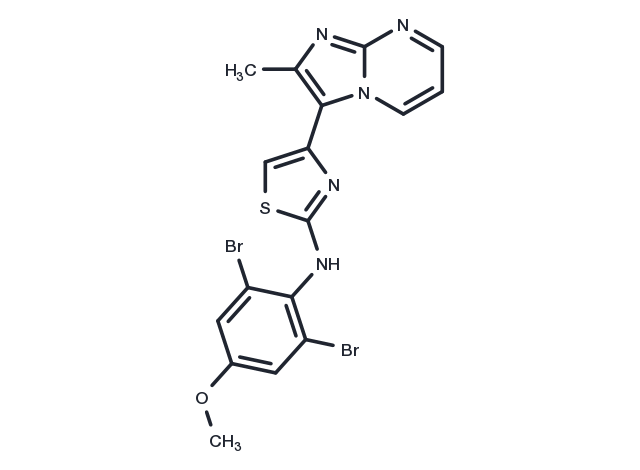Powder: -20°C for 3 years | In solvent: -80°C for 1 year
PTC-209 是特定的BMI-1抑制剂,不可逆转地损害结直肠癌起始细胞,在 HEK293T 细胞系中的IC50为 0.5 μM。它有抗骨髓瘤活性并损害肿瘤微环境。

| 规格 | 价格/CNY | 货期 | 数量 | |
|---|---|---|---|---|
| 2 mg | ¥ 535 | 现货 | ||
| 5 mg | ¥ 824 | 现货 | ||
| 10 mg | ¥ 1,224 | 现货 | ||
| 50 mg | ¥ 3,995 | 现货 | ||
| 100 mg | ¥ 4,850 | 现货 | ||
| 200 mg | ¥ 6,910 | 现货 | ||
| 产品描述 | PTC-209 is a potent and selective BMI-1 inhibitor. |
| 靶点活性 | BMI1:0.5 μM |
| 体外活性 | PTC-209能降低体内功能性的结直肠癌CICs的频率.PTC-209(60 mg/kg/day,s.c.)有效地抑制肿瘤组织中BMI-1的产生,并停止在具有原代人结肠癌异种移植物,人结肠癌细胞系LIM1215或HCT116异种移植物的小鼠中预先建立的肿瘤的生长. |
| 体内活性 | PTC-209通过不可逆的生长抑制破坏结肠直肠癌起始细胞(CIC)。PTC-209抑制人结肠直肠HCT116和人纤维肉瘤HT1080肿瘤细胞中UTR介导的报道基因表达和内源性BMI-1表达。PTC-209以BMI-1依赖性减少直肠肿瘤细胞的生长。 |
| 激酶实验 | Untranslated region-mediated luciferase reporter expression: HEK293 cells are transfected with a GEMS reporter vector that contains the luciferase open-reading frame flanked by and under post-transcriptional control of the BMI-1 5′ and 3′ UTRs. The resulting stable cells (F8) are treated with PTC-209 or vehicle control overnight, and then luciferase reporter activity is determined using Bright-Glo assays. The assays are run in triplicate for each point, and the percentage of inhibition was calculated against vehicle control. |
| 细胞实验 | To determine whether pretreatment with the inhibitor affects tumor cell growth, cells are plated with the inhibitor for 4 d in vitro and plated in limiting doses in vitro without adding further inhibitor. Trypan blue exclusion is used to count viable cells. The in vitro sphere-initiating cell frequency is calculated after inhibitor treatment by evaluating the number of wells containing spheres. For the experiments where LDAs are set up following recovery of PTC-209 treated cells, 6-well plates were seeded with 1E6 cells per well and incubated overnight. Cells are subsequently treated for 4 d in triplicate with either DMSO vehicle or PTC-209 (0.01, 0.1, 1 and 10 μM). Drug treatments are washed off and 4 mL fresh suspension medium added to all wells. To assess cell viability following the 4 d treatment window, cells are trypsinized and counted at 0, 24, 72 and 120 h after removal of the drug. Long-lasting effects of the drug treatment on sphere-forming ability are assessed by plating LDAs (50,000, 10,000, 1,000,100, 10 and 1 cell per well) using the cells obtained 120 h after the 4-d drug treatment.(Only for Reference) |
| 别名 | PTC209, PTC 209 |
| 分子量 | 495.19 |
| 分子式 | C17H13Br2N5OS |
| CAS No. | 315704-66-6 |
Powder: -20°C for 3 years | In solvent: -80°C for 1 year
Ethanol: 9.9 mg/mL (20 mM)
DMSO: 49.5 mg/mL (100 mM)
| 可选溶剂 | 浓度 体积 质量 | 1 mg | 5 mg | 10 mg | 25 mg |
| Ethanol / DMSO | 1 mM | 2.0194 mL | 10.0971 mL | 20.1943 mL | 50.4857 mL |
| 5 mM | 0.4039 mL | 2.0194 mL | 4.0389 mL | 10.0971 mL | |
| 10 mM | 0.2019 mL | 1.0097 mL | 2.0194 mL | 5.0486 mL | |
| 20 mM | 0.101 mL | 0.5049 mL | 1.0097 mL | 2.5243 mL | |
| DMSO | 50 mM | 0.0404 mL | 0.2019 mL | 0.4039 mL | 1.0097 mL |
| 100 mM | 0.0202 mL | 0.101 mL | 0.2019 mL | 0.5049 mL |
对于不同动物的给药剂量换算,您也可以参考 更多...
请在以下方框中输入您的动物实验信息后点击计算,可以得到母液配置方法和体内配方的制备方法: 比如您的给药剂量是10 mg/kg,每只动物体重20 g,给药体积100 μL,一共给药动物10 只,您使用的配方为5% DMSO+30% PEG300+5% Tween 80+60% ddH2O。那么您的工作液浓度为2 mg/mL。
母液配置方法:2 mg 药物溶于 50 μL DMSO (母液浓度为 40 mg/mL), 如您需要配置的浓度超过该产品的溶解度,请先与我们联系。
体内配方的制备方法:取 50 μL DMSO 主液,加入 300 μL PEG300, 混匀澄清,再加 50 μL Tween 80,混匀澄清,再加 600 μL ddH2O, 混匀澄清。
您可能有的问题的答案可以在抑制剂处理说明中找到,包括如何准备库存溶液,如何存储产品,以及基于细胞的分析和动物实验需要特别注意的问题。
PTC-209 315704-66-6 Autophagy Cell Cycle/Checkpoint DNA Damage/DNA Repair BMI-1 tumor cells inhibit anti-myeloma HEK293T cancer-initiating lung CICs breast PTC209 PTC 209 colon Inhibitor inhibitor
